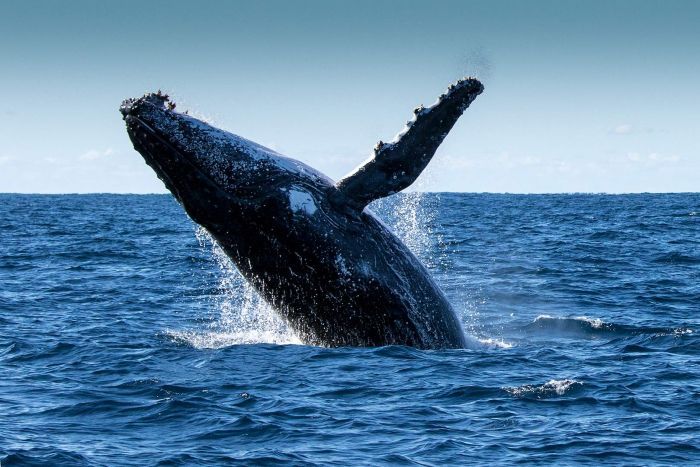Whale Watching off Straddie

During July to October the humpback whales can be witnessed travelling up and back down the coast by RBC members and their families who are prepared to venture east of Stradbroke or Moreton Island.
Nothing is more majestic than watching a 40 tonne whale launch itself into the air and crash back into the water creating a huge splash. Whale watching is an experience not to be forgotten. To see a humpback whale lift its massive body into the air, or slap the sea surface with its long fins, is a breathtaking sight and a special privilege. Whale watching involves many senses. As well as seeing whales, you can hear the characteristic sounds of the blow, smell the fishy rubber odour or hear the fin slap.
In the Southern Hemisphere humpback whales migrate from their summer Antarctic feeding grounds, along Australia’s continental coastline to tropical regions to breed and calve in winter. Most humpbacks return to the same breeding grounds for successive years.
Commercial whalers exploited humpbacks to the fullest between 1952 and 1962. They slaughtered about 10,000 along the east coast alone, from localities around Norfolk Island, Byron Bay and Tangalooma on Moreton Island. Populations were reduced to very low numbers, to possibly fewer than 500 animals in total by the end of the 1962 season. Humpback whales are now listed as “vulnerable” under the Queensland Nature Conservation (Wildlife) Regulation 1994.
Since the early 1960’s, when whaling was banned, the whale population has increased about 10% per annum, and it is estimated there are now over 20,000 humpback whales. Since 1978 observers have been conducting systematic counts, tracking and fluke identification off Point Lookout headland, in an attempt to estimate the status of the whale stocks, and this year over 1700 have been sighted.
After the migration passes Breaksea Spit at the northern end of Fraser Island, it enters the sheltered waters of the Great Barrier Reef and disperses widely between the Outer Barrier Reef and the coast. Calving usually occurs inside the reef at 18-19 degrees south, but has also been witnessed off Point Lookout.
Humpback whales are baleen whales, possessing plates of hair-like structures used to sieve prey from water taken into the mouth. They feed on krill and small schooling fish. They can grow to a maximum length of about 16 meters and weigh up to 40-45 tonnes. Females are usually larger than males of the same age. Humpback whales are long-lived, believed to have a life expectancy of about 50 years. Southern hemisphere humpback whales are generally dark dorsally and white underneath with a white underside to their flippers. A distinguishing characteristic of this species is the very long pectoral flippers (about one-third of total body length). Humpback whales are also well known for their spectacular breaching behaviour.
Humpback whales reach sexual maturity at an age of 5-7 years. Mature males ‘sing’ while migrating to and from the breeding grounds and while they are present at the breeding grounds. Mature females typically produce one young every two to three years although annual calving has also been reported. It is now thought that not all females out of the population migrate annually to the breeding grounds. Humpback whales have a gestation period of 11-12 months with calving occurring primarily between June and October. At birth, calves are about 4-4.5 meters in length. Calves are weaned at about 11 months.
When whale watching, a number of regulations must be followed. These help protect the whales while maintaining whale watching as an enjoyable experience for people.
Female humpbacks that are migrating south are often accompanied by young calves, which are particularly vulnerable to disturbance from people. Signs of distress can include prolonged diving, evasive swimming with rapid changes in direction or speed, and interruptions to breeding and nursing activities. If you see a whale and it looks distressed by your presence, please leave the area.
Whales are protected by Australian and Queensland laws, which are based on continuing research and management including regular boat patrols. Please follow these guidelines so the whales remain uninterrupted on their journey. A person in control of a boat must not:
- bring the boat any closer than 100m of a whale;
- bring the boat any closer than 300m of a whale if:
- three or more boats are already closer than 300m to a whale; or
- the boat is moving in a similar direction to or behind a whale; or
- the boat is moving at more than four knots; or
- bring the boat to a position that would cause a whale to come closer than 100m to the boat if the whale continued in its direction of travel;
- move or operate the boat in a way that causes the whale to alter its direction or speed of travel or its behaviour; or
- bring the boat between members of a pod of whales.
If you do not have a boat then whales can be seen from a number of vantage points at Point Lookout. On the North Gorge Walk, excellent views are obtained from Norms Seat and above Whale Rock. At the Frenchman’s Bay end of Timbin Road, elevated timber platforms have been provided, for views over Boat Rock and The Group rocks just offshore. Whales can also be seen from the beach behind the breakers midway down Main Beach. On their more leisurely return migration, whales can be seen in the waters between Shag Rock and the more distant Flat Rock. At these times Cylinder Headland and The Stradbroke Beach Hotel are excellent vantage points.
(This article is reproduced from the August 2007 RBC Bulletin)